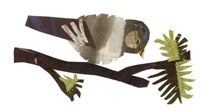The most surprising part is that it hadn’t happened before.
Loren Connors and David Grubbs first performed as a duo on May 30, 2003 at the Green-Wood Cemetery Chapel in Brooklyn, N.Y. Green-Wood Cemetery is one of Brooklyn’s landmarks - it’s the highest natural point in the borough, and an unexpected expanse of tranquility in the midst of the city. The stone interior of the chapel makes the quietest of sounds audible, and Loren and David played a remarkably quiet yet extraordinarily varied hour of improvised music. Energized, they repaired to the studio to record “Arborvitae”.
It certainly could have happened earlier. David first heard Loren’s “In Pittsburgh” LP (St. Joan) in 1990, and felt it a revelation. Loren’s example of creating silences, of singing - with the guitar - in silences, was crucial to David’s shift from the rock trio Bastro to the often percussionless Gastr del Sol. David and Jim O’Rourke reissued “In Pittsburgh” several years later on their Dexter’s Cigar label, and Loren and Gastr del Sol performed a number of shows on the same bill, including the 1996 Table of the Elements Yttritum festival in Chicago. Jim produced the self-titled “Hoffman Estates” album (Drag City), which featured a core duo of Loren and Alan Licht surrounded by the cream of Chicago’s improvisers. But never the twain did meet and play in duo until this year.
“Arborvitae” opens and closes with the pairing of David on piano and Loren on an electric guitar played so quietly that at times his pedal-stomping is wondrously distinct. “Blossom Time” and the title track positively float, with Loren alternating between soaring single-note lines and playing the rough, barnacled anchor to David’s relentless tide. David’s approach to the piano recalls his playing on Palace’s “Arise Therefore” (Drag City) and his own “Banana Cabbage, Potato Lettuce, Onion Orange” (Table of the Elements). Loren hypnotizes throughout. This is one of the rare instances in his career that he’s recorded in a commercial studio, and his playing time and again rewards such a detailed representation. “The Ghost of Exquisite” and “Hemlock Path” are two slow-motion lockings of guitar horns. “The Highest Point in Brooklyn” isn’t the place to be in an electrical storm - but it rolled in all of a sudden and there we were, uncovered and open to the elements...
“Arborvitae” proudly features cover artwork by the mercurial, demanding Cologne artist Michael Krebber.
Backgrounds
Loren began releasing his first LPs in 1978 on his own Daggett imprint. He has appeared on more than fifty albums under the names Loren MazzaCane, Loren MazzaCane Connors, Loren Mattei, and Guitar Roberts, many of these with the vocalist and songwriter Suzanne Langille. He has performed with a virtual who’s who of contemporary guitarists - John Fahey (who praises Loren in his forthcoming book “Vampire Vultures”), Thurston Moore, Henry Kaiser, Jim O’Rourke, Rafael Toral, Alan Licht, Dean Roberts, and numerous others. In 1999 Glass Eye Books published “Autumn’s Sun”, Connors’s first trade publication.
David Grubbs has been releasing records since 1982, but he’s not as old as you’d think. He was a member of the groups Squirrel Bait, Bastro, and Gastr del Sol, and has appeared in that famous non-membership organization The Red Krayola. He ran the Dexter’s Cigar label with Jim O’Rourke, and now directs Blue Chopsticks, which has released recordings by Luc Ferrari, Derek Bailey and Noël Akchoté, Workshop, Mats Gustafsson, and others. David’s 2000 album “The Spectrum Between” was named ‘Album of the Year’ in the London Sunday Times. His upcoming releases include a FatCat Split Series 12’’ with Avey Tare and an edition for the EN/OF label.
Personnel: Loren Connors: electric guitar; David Grubbs: piano, electric guitar
Tracks: 1. Blossom Time, 2. Arborvitae, 3. The Ghost of Exquisite, 4. Hemlock Path, 5. The Highest Point in Brooklyn




